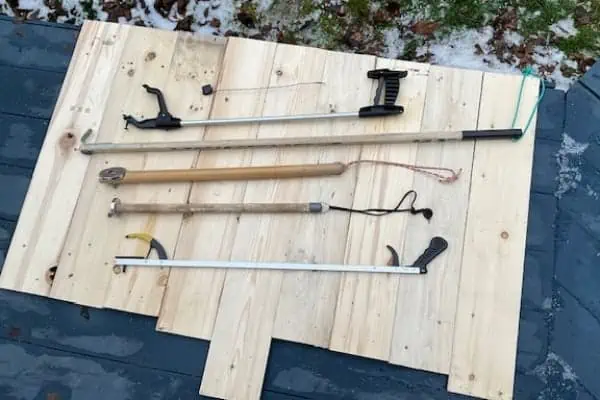Tarpaulins are a very important, but often under-utilized, piece of outdoor equipment.
There is no reason why a nature enthusiast shouldn’t have a bunch of tarps in different sizes, since they go on sale for half price at Canadian Tire a couple of times per year.
They come in different levels of quality, but the standard, orange, green, or blue plastic ones with the brass grommets are the most common and also reasonably durable.
Still, these standard tarps are heavier to carry than the high quality, reinforced (rip-stop) nylon ones, which are light enough for backpacking reasonable distances.
All tarps suffer if they are too close to the fire or, hung overhead, are in the path of the hot rising smoke and cinders. The plastic tarps shrink in the heat and can also catch fire themselves, and become dangerous.
The nylon tarps, which are much more expensive, get many small burn holes from the airborne cinders, so they need to be kept well upwind and away from the fire. A good rain keeps either type of tarp soaked (but not dripping), and fire is less damaging to a wet tarp.
A lot of light, strong rope and bungee cords ease the creation of rain shelters or “tarp forts,” as we called them when the kids were young.
A 10-foot by 12-foot tarp is a good start, but a larger one will make an even better protective structure.
If you have a tarp longer than 12-feet, you can fold the excess material back under the overhanging part to keep gear off the wet ground and keep the wind from blowing in the back way. Whether you have enough to fold under or not, peg the back corners. And if folded under, place a log or gear at the rear on the folded under part.
Halfway forward, on the part forming the slanting roof, run a very tight rope from tree to tree crossways under the tarp. Do the same thing at the high point at the front of the tarp.
Tie a non-slip knot to the crossing rope using the existing grommets at both the middle rope and the front rope. The tarp needs to be as tight as possible to prevent pooling of water in any sagging points.
If the rain is heavy and continuous, put a pole or two up to cause the water to run off. Put a pot or cup on top of each pole to keep it from puncturing the tarp under the weight of the rain.
The bungee cords allow enough elasticity to prevent the structure from blowing down from a sudden wind, and also help prevent punctures by poles.
If there is a fairly consistent, prevailing wind direction, then back the first shelter into the wind and build another one on the opposite side of the fire, facing into the existing shelter.
Keep a space between them wide enough for a reasonable sized fire. This way your firewood, storage, cooking and eating space can be out of the weather, and you’ll never want to go home.




